Animation Artifacts &Fleischer &Story & Storyboards 23 May 2012 05:32 am
Popeye Storyboard – part 3
- We’ve come to the third and final part of the storyboard for the 1949 Paramount Popeye cartoon, “Barking Dogs Don’t Fite.” These storyboard drawings come from the late Vincent Cafarelli‘s collection of artwork he’d saved from the divers studios in which he worked.
The storyboard was done by Jack Mercer and Carl Meyer. Their drawing styles are both expressive and markedly different. I suspect that one drew the human characters and the other the animals. The drawings of Bluto are just out of this world, ripped right out of the early 20th century comic book pages. I also suspect these were done by Jack Mercer, but I have nothing but a hunch to give me that guess. I believe he was working at the studio longer and might have had more of the early Fleischer grit in his drawings as opposed to the cartoon slickness that would’ve come from later employees’ work. Each drawing is done on inexpensive 8½ x 11 paper. As usual with these continuing posts, we pick up with the last drawing from last week’s entry.
 92
92
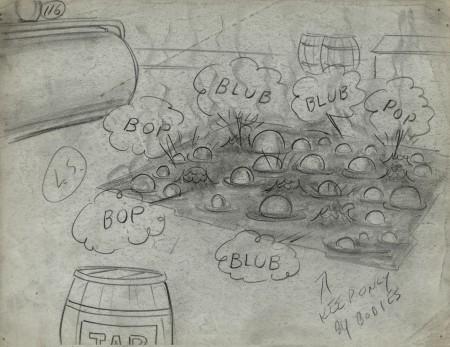 116
116
Note that drawing #117 is missing.
.
___________________________
Here’s the full short as seen on YouTube.
I wish the look was a bit closer to the board, however
some of the layouts in the final film are significant
improvements over the planning in the storyboard.
.
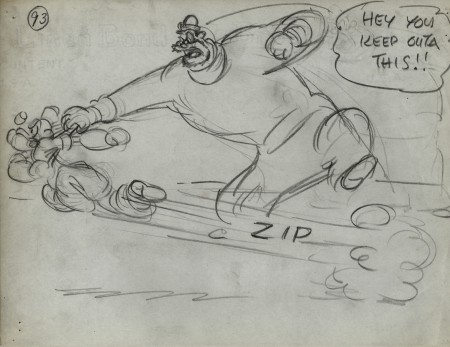
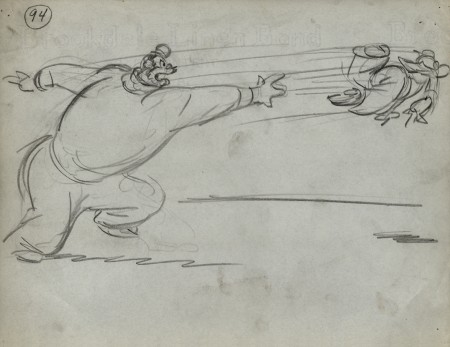










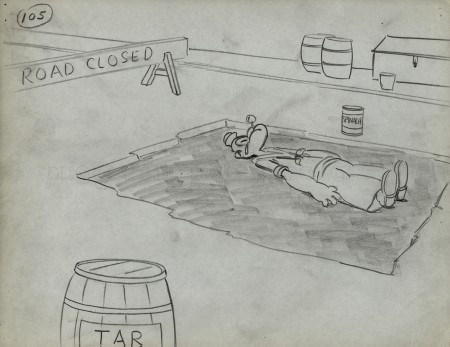









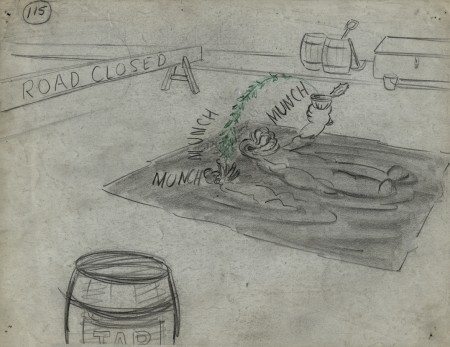



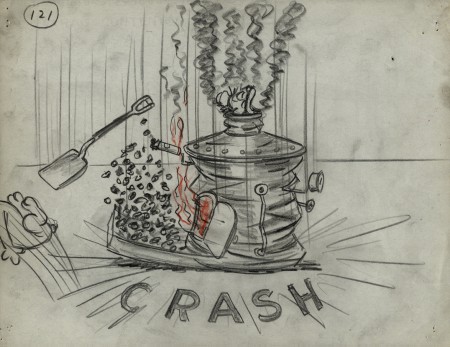
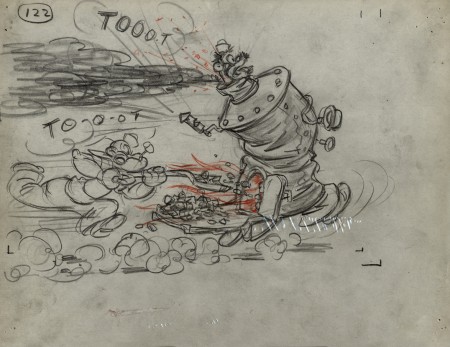











on 23 May 2012 at 1:15 pm 1.Eddie Fitzgerald said …
This Popeye board has been fascinating to follow. You’re right about the board drawings having more grit than the slick animated product. I’d argue that the story suffers from slickness as well.
At first glance the story seems perfect: it’s clear and simple, builds in a logical way, and has lots of opportunities for gags. It’s only when you see the story executed that you realize how flawed it really is.
Compare it to the the best of the black and white Popeyes. They’re full of digressions, and are as much about the funky world that Popeye lives in as they are about Popeye.
In those cartoons Popeye was alternately violent and sentimental and so was the world he lived in. The wonderful, built in contradictions made it difficult to make slick and logical stories, so the studio didn’t even try. They aimed for a logic of the heart rather than a logic of the mind.
On a different point, I’d hate to be an animator working on a slick and logical comedy. There’s no breathing room. In a logical cartoon all the animator can do is move the storyboard poses. Any deviation is seen as subverting the story.
Sometimes I think the present industry should be called the storyboard industry or the writing industry because the animator’s contribution is so slight. Isn’t this supposed to be their industry?
I’ll end by emphasizing that I do believe in a tight story. I also believe in a loose story that lets the animator shine. These are contradictory beliefs but grappling with contradictions is part of what art is all about.
on 23 May 2012 at 5:17 pm 2.Michael said …
Eddie, your comments are right on, of course. When I was a kid, desperate to work in animation when I grew up, I was terrified that I’d have to be drawing Popeye forever. Only after reading your comment did I realize that it was only the slick Paramount Popeyes that scared me. It would have been great to do the Fleischer B&W characters.
However, I just put together the post for next week – some model sheets from Fleischer Popeye and Betty Boops. Among them is a Betty Boop mouth chart for the planned improvised sections. The animators were to animate scenes where they knew mouth actions would be improvised, yet they had no idea what was going to be spoken. I guess there was no room for the animator to do any improvisation. That doesn’t sound like fun either.
on 23 May 2012 at 11:25 pm 3.Charles Brubaker said …
Michael, Eddie,
I’m wondering if you’ve seen this. Seymour Kneitel’s daughter posted a “bible” that was put together near the end of the Fleischer Studio’s run (and was subsequently put into use at Famous Studios). This may explain some things about the quality of these cartoons.
http://seymourkneitel.blogspot.com/p/standard-production-reference.html
And Eddie, as someone who is currently looking for work in animation, yeah, there’s some truth when you say “storyboard industry”. In modern-day shows, just about all the important decisions on what goes on-screen is made during the storyboard stage; layouts, animation, etc. is expected to follow what’s in the boards.
I remember you saying that modern-day storyboarding is close to directing. This is especially true in Japan (in fact, Japanese animation directors often do the storyboards themselves; this was the standard back in the ’60s and it’s still somewhat true today).
on 23 May 2012 at 11:57 pm 4.Michael said …
Vinny Cafarelli has an original copy of that Fleischer bible in his maerial, and I was debating posting it, myself, even though I know it’s at the Kneitel site.
It deserves as much exposure as ossible, and I might use the opportunity to comment on it.
on 24 May 2012 at 1:26 am 5.J Lee said …
Comparing this cartoon to the original, “Protek the Weakerist”, what’s noticeable — and what explains a lot of the problems with the pos-1948 Popeyes — is where the story emphasis is placed.
In the original, much more of the cartoon is spent on the segment where Popeye is trying to hide the fact that he’s walking what he considers a sissy dog, while the fight scene leading up to the spinach sharing is pretty brief by comparison. In contrast, here we only get a brief segment where Popeye shows his embarrassment at being with the dog before we get into the confrontation with Bluto, but the fight segment is longer, and we get the extended pre-spinach bit with the steamroller. So in the Fleischer version, the focus is on the comedy — the ‘drama’ part is over and done with relatively quickly, while in the remake, we’re asked to care more about the drama via the threat to Popeye and Frenchy … which we really don’t, because we already know how it’s going to end.
The odd part is when Seymour Kneitel was head animator under Dave Fleischer, his Popeyes were normally less focused on making Bluto menacing and more focused on the comedy than the ones handled by the Willard Bowsky or Dave Tendlar units, where Bluto at times could be a misogynistic psychopath (which, to be fair, made Popeye’s pummeling of Bluto at the end of the cartoon more enjoyable to the audience). Yet by the end of the 40s and into the 1950s, the Bowsky-Tendlar plot path was the default storyline for the series, but minus most of the better executed gags and Jack Mercer’s mumblings.
on 24 May 2012 at 3:20 pm 6.The Gee said …
that Fleischer bible:
wow.
The presentation format is a little awkward, especially with some of the landscape formatted pages. But, I’m nitpicking. Obviously it took a deal of effort and it is good to know it is online.
Thanks for sharing it.
on 24 May 2012 at 4:58 pm 7.The Gee said …
“On a different point, I’d hate to be an animator working on a slick and logical comedy. There’s no breathing room. In a logical cartoon all the animator can do is move the storyboard poses. Any deviation is seen as subverting the story.â€
By “slick and logical†you mean the really chatty stuff? Sit-commy stuff?